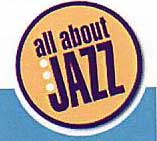

|
THE
NEW YORK SUN WEEKEND EDITION, JULY 30-AUGUST 1, 2004 PAGE 21
J A Z Z
Supersize
Monk
By WILL
FRIEDWALD
Thelonious
Monk’s works are easily the most performed of anyone other than Duke
Ellington, yet his music represents a particular challenge to contemporary
interpreters. There would be no point in playing Monk’s music exactly as
he played it - you can’t compete with him at his own game - but if you
change too much you risk sacrificing the music’s essential Monkishness.
Village Vanguard JOHN STETCH Exponentially Monk
There’s
no point playing Monk’s music exactly as he played it—you can’t
compete with him at his own game. But change too much and you sacrifice
the music’s essential Monkishness.
In
March, an all-star band featuring the late Steve Lacy, Dave Douglas, and
Roswell Rudd offered its interpretations at the Iridium. Now there are two
more very worthy Monk tribute offerings. The Ben Riley Monk Legacy Band
led by the drummer most associated with the late composer, works this week
at the Village Vanguard - the club most identified with Monk. And a new
CD, Exponentially Monk (Justin Time 206), has just been released by the
Canadian pianist John Stetch.Monk was first and foremost a piano player, who laid his distinctive touch upon many a showtune and pop standard that he himself did not compose (in fact, many of his own compositions are variations on standards). Therefore the piano remains central to any re-consideration of Monk’s music, even when—as in the case of the Riley septet—it isn’t there. The Riley unit more accurately should be titled the "Ben Riley-Don Sickler Monk Legacy Band" since trumpeter Don Sickler serves as its co-leader, conductor, and musical director. He has written the arrangements for a seven-piece band of four horns and three rhythm. Even though guitarist Freddie Bryant is also a prominent part of the band, Mr. Sickler resisted the temptation to let the guitar take the place of the piano. Mr. Bryant plays with an appropriately Monkish percussiveness, but he supplies horn-like, single-note-lines, rather than comping chords like a pianist. Overall, this is one of the finest efforts I’ve heard at translating Monk’s compositions and ensemble sound to a larger ensemble. The band’s texture is reminiscent of Monk’s early recordings as a leader, since that was the only point in his development when he routinely worked with two or three horns. Everything else about the group, though—especially the drumming of Mr. Riley—suggests Monk’s classic quartet of the 1960s. Despite some fine soloing from saxophonist Wayne Escoffery - who, among other things is probably the tallest tenor since Dexter Gordon - Mr. Riley is the dominant musical force in his band. His drumming is at once propulsive and unintrusive The Vanguard show included many of Monk’s most successful reworkings of familiar standards: Bright Mississippi (both the harmonies and the title are a play on "Sweet Georgia" - "Brown," that is), "Evidence" ("Just You, Just Me"), "Let’s Call This" ("Honeysuckle Rose"), "Bemsha Swing" and "Rhythm-A-Ning" (both of which use "I Got Rhythm" in different ways). Monk disdained the act of trashing the melody and using just the chords, and in all these pieces you can follow both the original melody and the new one Monk lays on top of it Mr. Stetch’s take on Monk, of course, is entirely piano. But both Mr Riley and Mr. Stetch alternate between familiar’ and obscure Monk tunes (coincidentally, both play the lesser-known "Gallop’s Gallop" from 1955). Both also play Ugly Beauty. Monk originally wrote this song as a ballad in the usual 4/4; it was Mr. Riley who heard the melody at the recording session, suggested that it might work better in 3/4, and thus transformed it into Monk’s only waltz. Mr. Stetch’s treatment is slow and simple, combining Monkish open spaces with an introversion that suggests Bill Evans. His Well You Needn’t, on the other hand, is a more radical reinterpretation: The opening chorus has Mr. Stetch stating the chromatic melody with his right hand on the keyboard and his left hand inside the piano, picking out a pizzicato accompaniment as if it were a bass. It’s a question of Monk Orthodox versus Monk Reform, with both Mr. Riley and Mr. Stetch assuming both roles at different times. But if you fear that creative musicians have run out of interesting ways to play Monk’s music - well, you needn’t.
Ben
Riley’s
Monk Legacy Septet at the Village Vanguard
Russ
Musto, AllAboutJazz.com August 2004

The
Village Vanguard closed out July with a weeklong engagement by Ben
Riley’s Monk Legacy Septet. The band, featuring guitarist Freddie
Bryant, bassist Essiet Okon Essiet, trumpeter Don Sickler, and a saxophone
section of Bruce Williams (alto), Wayne Escoffery (tenor) and Jay Branford
(baritone), was in full swing Wednesday July 26, negotiating Sickler’s
unrestrained arrangements, driven by Riley’s rhythmic exhortations, with
skillful abandon. Beginning with
Shuffle
Boil, Sickler employed an engaging formula,
dividing Monk’s multifaceted melodies into a succession of short phrases
played by different players, often with horns or guitar riffing
alternating staccato and legato backgrounds and Riley interjecting drum
interludes that mimicked Monk’s dancing rhythms. The method worked
particularly well on Straight
No Chaser, which began dramatically with a cappela horns and
culminated with an extended drum solo.
The
Star-Ledger
THE NEWARK STAR-LEDGER THURSDAY, JULY 29, 2004
Monk
minus keyboards
Riley’s septet rises to challenge of presenting bebop legend’s legacy
BY
ZAN STEWART
Star-Ledger Staff
NEW
YORK -- Thelonious Monk’s combination of thoughtful, punchy, often
memorable melodies, subtle-to-provocative harmonies and hefty, sometimes
surging rhythms gives his music an undeniable timelessness. This was
proven again with the premiere of drummer Ben Riley’s Monk Legacy Septet
Tuesday night at the Village Vanguard. Monk, one of the bebop movement’s
core figures, wasn’t called "The Genius of Modern Music for nothing." |
| SEPTET | CLIPS | REVIEW1 | REVIEW2 | REVIEW3 | BEN&DON | CONTACT | CALENDAR | LINKS |